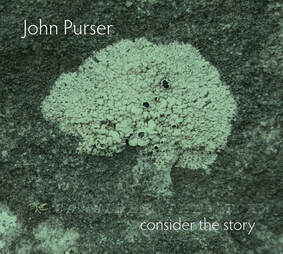 Winter saw the emergence of my latest CD consider the story, beautifully designed by my son Seán, and with wonderful performances from so many different musicians I have worked with over the years. So far, it has been well received, not least myString Quartet ‘Kalavrita’ of which John France wrote “It does not matter whether you regard this work as a threnody for the massacred or as deeply disconcerting absolute music. This is the masterpiece on the disc, one of the finest pieces I have heard from Purser’s catalogue.” (MusicWeb-International,12.12.2021). The Brodsky Quartet give the piece every chance. News on the croft is that the cattle are being fed the hay from the east of Scotland which comes in small ‘square’ bales, easy to manage. We started feeding in January. Julie is due to calve any day, and Dedee is also in calf but not due for a few weeks yet. It’ll be Julie’s first calf and as she is not the brightest of our cows it’ll be interesting to see what she makes of her responsibilities. If she has any sense, she’ll hold off until the weather improves. It has been mostly wet, windy, grim and miserable for months, with only the odd decent or half-decent day, and the sun too shy to put up much of a show. At least the snowdrops are in full bloom and a thrush is beginning to announce impending spring from various treetops. There is hope. This month I became an octogenarian. I am told this is about right as my body feels like 90 and my brain like 70, so the result splits the difference. Family came up in relays and I was overwhelmed with love, gifts, superb meals and general indulgence. Now it is time to revert to good old Purser Baptist values; tighten the belt, fit a truss round the slackening morals, and continue in the never-failing holier-than-thou approach which has served me so well over the decades. 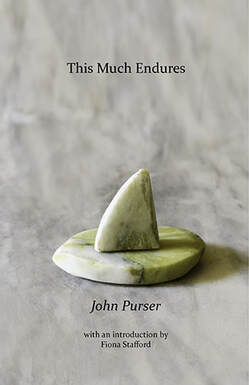 This month saw the publication of my latest book of poetry This Much Endures. Kennedy & Boyd have made a really beautiful job if it. The cover features a little marble boat I made from Skye marble for my daughter’s birthday. There is a poem to match it. Fiona Stafford of Somerville College, Oxford, wrote the introduction. Here are two quotations from it: “The celebratory tone of so many of John Purser’s poems is set against the profound bleakness of others. The volume’s overall truth derives as much from the poet’s understanding of the pain and injustice of the world as from his recognition of what helps to combat the darkness.” “From first to last, the voice of the poems speaks with the economy of tested truth: utterly assured, utterly convincing.” Besides the poetry book, a piece I wrote for solo recorder received its world premiere in The Red House – Benjamin Britten’s home in Aldeburgh – as part of the Alwyn Music Festival. The recorderist John Turner was the commissioner and performer. I wrote the piece at his request and it is dedicated to him. It’s called Skye Blue and is as happy as the title may suggest. My son reminds me that Blue = Blues – but not here on Skye after a glorious summer with blue skies for weeks. Skye Blue is being published by Forsyth of Manchester and it’s also out on CD Hat Box Primafacie PFCD166 Track 12, in lots of good company. It’s that rare thing these days, a CD full of fun and entertainment and totally unpretentious, all expertly played. News on the croft is that the cattle are back in from the common grazing and the hay has arrived from the east of Scotland in small ‘square’ bales, easy to manage. We start feeding in January unless the weather is really bad. We had been catching crab, mackerel and the occasional lobster, but it’s now too cold to be out in an open boat, so we have brought the pots in and stowed the boat here on the croft. Midsummer. Scarcely dark. We put the crab pots out and have caught a good few brown crabs and one dogfish so big he couldn’t swim inside the pot and so died and became bait for the crabs. I caught another massive dogfish on the darrows the other day, but, mercifully, he fell off the line. They are almost indestructible and can bite your toe or finger off – and they are immensely strong and aggressive. Window to the West has received a wonderful review from one of the most respected of Gaelic scholars, Ronald Black. He has understood and embraced the intention as fully as Meg Bateman and I could ever have hoped. Here are some of his comments: “[it] is a very fine book, and in many ways an extraordinary one ... its breadth and depth are astonishing ... Window to the West is nothing less than a rounded portrait of Scottish Gaelic civilisation ... instead of saying with MacGregor ‘our Gaelic learning isn’t worth a spit, study other people’s’, they say, ‘let’s respectfully examine the Gaelic contribution to understanding, in all its different categories, and see what it has to tell us’. That is the point of Window to the West, and the result is so impressive that it might have made even James MacGregor have second thoughts ... The lack of a historical time-line in Window to the West is thought-provoking. We are accustomed to viewing history like a tree which produces more and more fruit the higher up it grows, because the earlier centuries, down at the bare trunk, tell us so little. Window to the West isn’t like that. It’s a tree which keeps on giving, from the root almost to the very top. And all historians can learn from it.” (West Highland Notes and Queries, Series 5, No.2. July 2021. Of course both of us are much indebted to Ronnie’s scholarship over the years, not least in his wonderful series of essays ‘The Quern-dust Calendar’ in The West Highland Free Press, and his seminal edition of Campbell’s The Gaelic Otherworld. His approval of what we have done is heart-warming.
I hadn’t quite realised that it’s nearly 2 years since I last blogged… I forgot to post last year and, since Covid-time represents a kind of suspended animation, I guess it doesn’t matter...  McCulloch, Geological Map of Scotland (1840) , National Library of Scotland McCulloch, Geological Map of Scotland (1840) , National Library of Scotland WINDOW TO THE WEST My big news is that Meg Bateman and I have finally published Window to the West online with Clò Ostaig – the publishing division of Sabhal Mòr Ostaig. It's 960 pages so takes a minute or two to download, but it’s free, and if you click on anything blue it takes you there, so it’s easy to navigate. There is and will be no paper edition. Here is the link. Meg and I worked together on this for well over ten years and we never fell out. We have swum against the academic tide by being broad and ambitious. I’m immensely grateful to Meg for her knowledge, wisdom and readiness to embrace a truly holistic multi-disciplinary approach, but that is how the Gaelic world operates, so we make no excuses for reflecting it. We hope you enjoy exploring it. There’s a lot in there.
Poets On the poetic front, I was down in Glasgow for Aye Write! Reading my poem Croftwork. It’s in my collection There Is No Night and James Naughtie had selected it. I was keeping company with Liz Lochhead, Jennifer Williams, Jim Carruth, Angus MacNicol and Tom Pow. Jim had chosen our poems and introduced us, along with Colin Waters from the Scottish Poetry Library. It was good to catch up with Jim. Years ago I interviewed him about his music teacher, Ronald Center, whose music we both admire. Each poet got to choose another poem from any period of Scottish poetry. I was the only one to choose a poem not from the late 20th century. It’s a sonnet by William Drummond (1585-1649) of Hawthornden. Down the Esk gorge from Roslin Chapel you can see his house perched on the edge of the red sandstone cliff. The poem is brilliant, so here it is: “Sound hoarse sad Lute, true Witnesse of my Woe, And strive no more to ease selfe-chosen Paine With Soule-enchanting Sounds, your Accents straine Unto these Teares uncessantly which flow. Shrill Treeble weepe, and you dull Basses show Your Masters Sorrow in a deadly Vaine, Let never joyfull Hand upon you goe, Nor Consort keepe but when you doe complaine. Flie Phoebus Rayes, nay, hate the irkesome Light, Woods solitarie Shades for thee are best, Or the blacke Horrours of the blackest Night, When all the World (save Thou and I) doth rest: Then sound sad Lute, and beare a mourning Part, Thou Hell may’st moove, though not a Womans Heart.” Peats
The sun is shining away but the air is cold and it is windy, so even though we are working hard at the peats, Arran-Island sweaters are the order of the day. We had great help from family with the first two long bogs, but the last bog had to be skinned, which we did with me marking out the turf with the chain saw and Ross using the ceapair lar to lift the sods and, with a twisting action, turn them into the ditch for Bar to set them out neatly. I get pleasure out of the combination of the chain saw in its growling modernity and the ceapair lar, which dates back in design to the Iron Age. I used to do both jobs but it’s tough work so these days Ross does the tough bit. Yea! Bless him!. Now Bar and I are cutting the peats and doing away not too badly for septuagenarians. A crazy morning, this morning. Julie, our young lovely dark brainless heifer, didn't turn up for breakfast at the pens. We both and our neighbours Katie-Mary and Ruairidh searched the crofts, but no luck. Finally Bar spotted her trapped under an abandoned lorry trailer. She had stepped in over a metal bar and couldn't figure how to get out. From the pile of cow dung she must have been there all night, poor soul. We had to saw and bash away the metal bar, with rusty metal falling on Julie's head, so she was even more spooked. Eventually Ruairidh pushed her head enough to persuade her to engage reverse gear. She doesn't know Ruairidh so that may have been an added incentive for she finally backed out scraping the top of her back on the underside of the trailer. Bar sprayed her back so it doesn't get infected.
In the middle of all this I was fielding a phone call about an enigmatic object dated to 500 BC and which may well be another bridge for a stringed instrument, though not the same kind as the High Pasture Cave one. The Oakbank Crannog Centre are working on a major outreach programme in which this object will have a starring role. Today my piece for Taonga Puoro (Maori musical instruments) and bassoon is up on the web. It's called Puna. I mentioned it in an earlier post. Now you can hear it at: https://www.youtube.com/watch?v=9rw4NuB3V5s On Thursday I am invited to chat to/with the first year Gaelic students at Sabhal Mor Ostaig. I still can't believe that my Gaelic is good enough. It's not so very long ago since I was one of them - well, 20 years but I was already 60. Is that an excuse? Murchadh MacLeoid is still there - a wonderful teacher who makes everything fun and possible. Twice recently the past has caught up with me in unexpected ways.
I had almost forgotten a composition I wrote for taonga puoro and bassoon - that's Maori musical instruments and bassoon. As one does. The piece is called Puna which means a spring or water-source. This one is at Hamurana on Lake Rotorua and roughly 4 million litres per hour surface there, silently, smoothly and, at 10 degrees C, very cold. I remember it well enough as I skinny-dipped there with the Maori artist James Webster, and Pania Witoko. It would kill me to do that now. The bassoonist, Ben Hoadley asked me to compose Puna for himself and Richard Nunns to perform in the British Museum in front of the collection of Maori artefacts and they did so back in 2005. I remember that occasion well too, because a young New Zealander was so moved by hearing his people's instruments played live in the Museum, that he broke into a spontaneous celebratory haka. But that, I thought, was that. When would a piece for bassoon and Maori traditional instruments ever be played again? Only last night a link came through to a performance of Puna in Aotearoa (New Zealand) in March last year. It is, of course, Ben Hoadley, but this time with Rob Thorne on taonga puoro, and the playing is really beautiful. It should be up on the net soon. Thanks guys! What a wonderful memory to come alive again so vividly. The other call from the past was a request to write a word or two about the playwright and poet Joan Ure (Betty Clark). A book of her poems, The Tiny Talent, has been published in Orkney and the publishers have invited people who knew her to send in a word or two. My piece is titled Visiting Meikle Mochrum and is up there on the BRAE editions website. Joan's poems are sensitive and subtle - and the book is very nicely produced. Well worth buying. Meanwhile, miniature daffodils declare war on winter, along with crocusses and snowdrops and hellebores. Even the willow has pussies on it. We humans, however, being much less hardy, negotiate regular truces, and the cows accept it all with their usual stoicism. I have for some years been boasting that I am Scotland's greatest cow poet, but I have been demoted by a better one - Jim Carruth, who was made Glasgow's poet laureate or makar in 2014. Jim comes from a Renfrewshire farm and his poems about farming life and life in general are really beautiful. However, we are both on a par in James Naughtie's selection of "The Best of The Best" poems for the Scottish Poetry Library as Jim and I are two of the twenty selected from fifteen years of "The Best" of each year. My poem is about cows and his is about a mole-catcher. You can read them on the Scottish Poetry Library website, along with various comments from the earlier editors of "The Best" and from James Naughtie and the poets themselves.
I interviewed Jim Naughtie a while back for a radio programme. Yes, I know, he is the radio interviewer, but I wanted him to talk about Ronald Center, his piano teacher in Huntly long ago for one of my Scotland's Music programmes. Center was an outstanding composer. Jim was as good an interviewee as interviewer. I look forward to meeting him again when he presents his choice of poems at the Aye Write festival in Glasgow on the 30th March, when some of us will be reading our poems and one other Scottish poem (any period) of our own choice. I think I will go for a Drummond of Hawthornden sonnet. I am working on the third edition of Scotland's Music and have recently been doing a statistical analysis of triadic 4-note patterns in a 1766 fiddle manuscript. Esoteric or what? But it is in fact very interesting because it highlights the extraordinary inventiveness of Scots fiddle music composers working with a deliberately limited harmonic palette. They knew how to make a lot out of a very little. If only Haydn and Mozart had known what the Scots were up to they would have made their viola and cello parts much more interesting, instead of their usual do-dee-da-dee pattern going on endlessly while the violin does its prima-donna thing. I went down to Glasgow by train from Mallaig on Thursday, beautiful, snowy, to hear Stuart MacRae's new opera Anthropocene. It was not an easy listen, but there was one truly beautiful section when the Ice-maiden first realises she is alive. The repeated descending bass line, harp, I think, and the voice beautifully hesitant, perfectly pitched, made for a little spell of wonderful music I will never forget. I had a chance while down to see my son, Sean's photographic exhibition Heids in the Glasgow Royal Concert Hall - part of Celtic Connections. If you don't know about the Festival, look it up. The photos are of some of the previous year's Celtic Connections musicians and they are absolutely brilliant. Intimate, funny, revealing, touching, always totally natural. Nothing posed. Back up on the train the next day; all the snow gone, low mists obscuring everything. So what with the poets, the new opera, and the Celtic Connections photographs, Scotland's cultural scene is vibrant. Long may it continue so. Many moons have risen and set since my last blog, some of them beautiful, some of them sad. Three dear friends and colleagues died recently - John Geddes and Martin Dalby, and now Tom Leonard. All three outstanding voices and personalities in the Scottish arts. John and I were students together at the RSAMD and fellow composers, never rivals - and the same holds true for Martin who was my producer for BBC Radio Scotland's first series of Scotland's Music. I wrote their obituaries for The Herald - a strange responsibility when what one remembers above all is simply the fun and the companionship. And Tom, who became my friend through our mutual love of the music of Carl Nielsen and whose deeply sensitive and incisive honesty lived alongside a wicked wit. What a writer! It was at the end of 2017 that I lost one of my oldest and deepest friends - the American sculptor Charles Wells. We met in Pietrasanta in 1974 and he taught me a little stone carving. His work was stunningly beautiful and his etchings were searching and strange. I stayed with him and his lovely wife, Diana, in New Mexico and Pennsylvania and they came often to join Bar and myself on Nashawena Island. I will never forget his first arrival on Skye and on the summit plateau of Ben Meabost, with low grey scudding clouds and he dancing away from me, loose-limbed, and turning round to exclaim with joy "Gee, John I just wanna disperse!" This ageing business finds me included in Autumn Voices (edited by Robin Lloyd-Jones) as an interviewee and interviewer, alongside other old friends, mercifully still alive and including Alasdair Gray, Stewart Conn, Sheena Blackhall and Carl MacDougall: so we are now approaching that stage when we become pickled specimens to be placed on shelves beside scorpions in bottles and the like. All of which obliges one to further creative output in order to upset the assessors. On that front, I have recently been commissioned to write a new piece for a new instrument - Donald Lindsay's Lindsay System chanter which has extended the range of the small pipes chanter at both ends. We have decided that my piece is to be called An Grianan, the sunny place, because it is happy. Not a cloud in its sky. Donald is going to play it when he presents an original pipe next week to the Piping Centre. 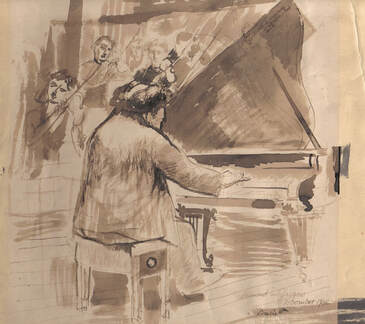 I've also been writing essays for The National - centre-page spreads with no ads and plenty of images. You won't find anything like it in any other daily newspaper anywhere. The first eight were re-published alongside Alan Riach and Alexander Moffat's essays in Arts and the Nation, Edinburgh 2017. The image is of the cover illustration - William Crosbie's drawing of Frederick Lamond playing with the Scottish Orchestra in 1942, the year I was born and no distance from Bill's studio. He was a close family friend. Since then I have written a good few more essays, the latest being on Scottish artists associated with the Celtic Revival. You can access them on-line on The National's website, under Culture. They have been coming out on Mondays. The 7th of January will be the last for a while. I've been publishing an occasional poem and was honoured to be invited to give the Andrew Fletcher of Saltoun Annual Memorial Lecture in The Scottish Parliament in February of 2018. I called it From the Hebrides to Hindustan: cultural self-perception and the music of Erik Chisholm. Linda Fabiani, the MSP to whom we are indebted for the lecture series, told me afterwards that her husband had regarded the title with the greatest misgiving, but she, I am happy to say, was all enthusiasm about the outcome! I was also asked to give the Alan Bruford Annual Memorial Lecture in October at The Scottish Story Telling Centre. This one was called Scotland and the Fenian Lays - a more accessible version of a paper I gave at the Ulidia/Finn conference at Sabhal Mor Ostaig back in May. Perhaps nicest of all compliments were the ones paid to me by Ellen Beard who asked me to write a Foreword to her splendid 100 Òran le Rob Donn MacAoidh, published on the Isle of Skye in 2018; and then, at the very end of the year, to find myself joint dedicatee of Elizabeth Ford's equally ground-breaking publication of William McGibbon Complete Sonatas, published by A-R Editions in Wisconsin. It is quite wonderful that such good work is still finding the light of day and excellent productions and from such different corners of the world, though, be it noted, both authors are citizens of the USA. But I am not going to stray into the world of visas and the xenophobic racist agenda of the Home Office and the Government in general. The year is young and who knows what spring may bring. The whirligig of time will surely bring in its revenges. With the launch of Re-Soundings at An Lanntair arts centre in Stornoway came the chance to catch up with old friends like Malkie MacLean, and also to appreciate how the music went with the exhibition. I think it goes well, and the handsome brochure has a CD with it. Return to Skye to greet our cousins with whom we went to Kilda. Low mist obscured much of the island, and the military presence is all too obvious: but the houses and cleats and dry-stone enclosures in the higher corrie are immensely impressive, as was the sense of the void when we reached the cliff edge and could see nothing but mist and hovering fulmars and the sound of the sea infinitely far below. 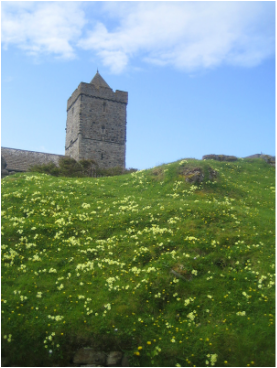 Our return was excitingly rough and took us close up to the stacks with their thousands of gannets and impossible human achievements - men surviving marooned for seven winter months on one of them. Wild Soay sheep are still breeding on the largest. We took particular pleasure in Rodel Church and its stone carvings, and a visit to Donald Alick MacKinnon, our neighbour Katie's brother, at Scadabay. Old times fondly remembered. Since then there was the Jon Schueler Symposium at Sabhal Mor Ostaig. One of the most inspiring and friendly of such events ever. I spoke about my own music and how it relates to the land- sea- and sky-scapes here, and married much of it up with Schueler's paintings. People liked the music and bought all the CDs I had with me. Quite remarkable. Magda Salvesen - Schueler's lover for many years, and Ricky Demarco undiminished in energy in his mid-eighties, were there, and members of the Mallaig fishing community who had known Schueler and taken him with them and who remembered him with love. All the presentations were good and the atmosphere a real tribute to a man whose paintings I have come deeply to respect and who I wish I had known. Astonishingly lovely warm sunny weather has dried all our peats and ours are now safely in the shed, as our most of our neighbours' all thanks to "Kay" the brilliant Polaris Ranger ATV. Meanwhile the house is being painted white by Graham and Kevin and the new raised beds being made by John and Merry and the post holes for the deer fence by Ruairidh - but we are working hard too, not just at the peats: Bar with many gardening ploys, I planting the potatoes (Golden Wonders and Blue Danube), and occasionally thrusting Big Bertha (our massive pinch-bar) into solid basalt to the general and simultaneous destruction of man and rock.
Meanwhile, the first of three long essays I have written on MacKenzie, MacCunn and McEwen respectively has come out in last Friday's National. The series got a plug on the front page. Cool or what? These guys get so little attention and deserve so much and it is great to have a national newspaper give them this sort of coverage - a double-page spread with excellent images. Stornoway next week for a workshop to go with Re-Soundings and then work with Meg Bateman on finalising Window to the West, now in its eighth year and teetering on the edge of completion. It has been an amazing and happy adventure and Meg and I have never once fallen out over it. What is it? Everything . . . . of which two little bits will be my and Meg's papers: hers on colour (she gave a great one at the Schueler symposium which really did open people's eyes to how differently colour was understood in the Gaelic-speaking world. Mine will be on ogam. |
John PurserJohn Purser is widely known as a composer, musicologist, poet, playwright, and broadcaster. Archives
February 2022
Categories |
copyright © 2014 John Purser










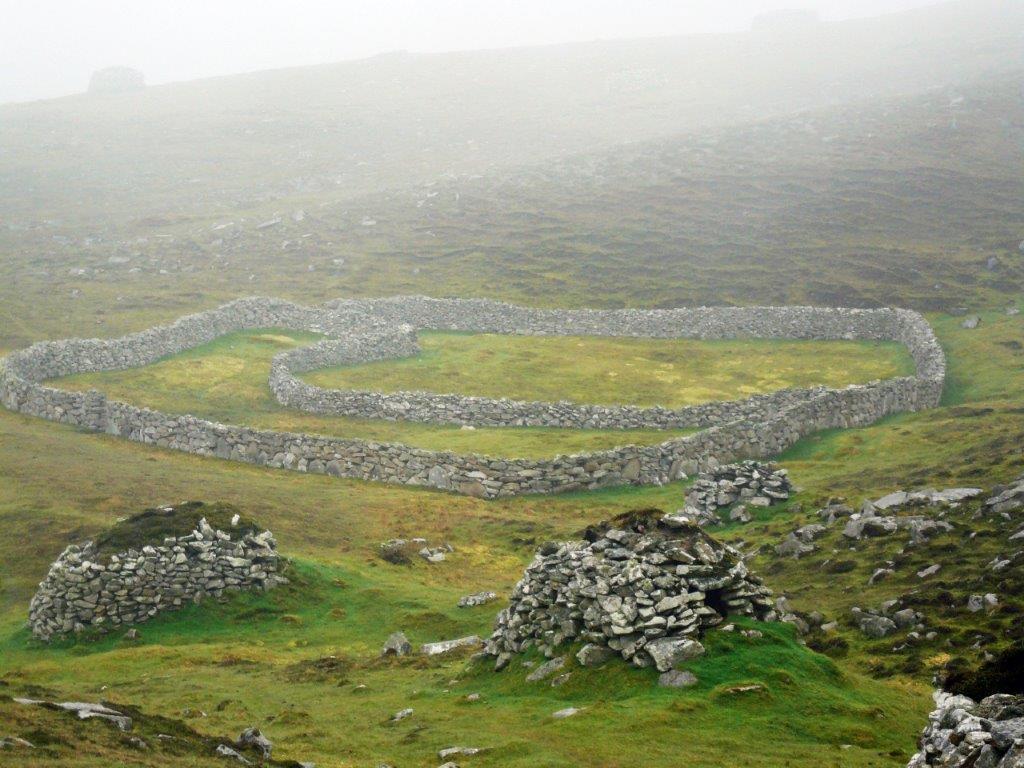




 RSS Feed
RSS Feed